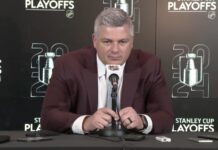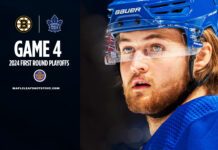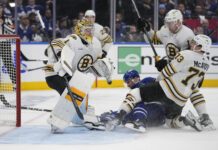So, want to see Shanahan’s secret list? The one that’s going to speed up the Leafs’ rebuild? Sure you do.
It’s Brendan Shanahan’s list of his former European and Russian teammates, but it’s a lot more than a nostalgia thing. It’s networking gold.
It gives Brendan Shanahan the single best network into high-end European and Russian hockey talent of any NHL executive.
| All-Time - Euro Forwards | All-Time - Euro D-men | All-Time Save % - Euro | |||
|---|---|---|---|---|---|
| Jaromir Jagr | 1802 | Nick Lidstrom | 1142 | Dominik Hasek | 0.922 |
| Peter Stastny | 1239 | Freddie Olausson | 581 | Henrik Lundqvist | 0.911 |
| Sergei Fedorov | 1179 | Sandis Ozolinsh | 564 | ||
| Patrik Elias | 1017 | Reijo Ruotsaleinen | 344 | ||
| Pavel Datsyuk | 869 | Niklas Kronwall | 339 | ||
| Tomas Sandstrom | 857 | Uwe Krupp | 281 | ||
| Vyacheslav Kozlov | 853 | Dmitri Mironov | 260 | ||
| Henrik Zetterberg | 786 | Fyodor Tyutin | 248 | ||
| Bobby Holik | 747 | Vyacheslav Fetisov | 228 | ||
| Martin Straka | 717 | Vladimir Konstantinov | 175 | ||
| Peter Nedved | 717 | Alexei Kasatonov | 160 | ||
| Robert Lang | 703 | Johnny Oduya | 152 | ||
| Michael Nylander | 679 | Karel Rachunek | 140 | ||
| Igor Larionov | 644 | ||||
| Esa Tikkanen | 630 | ||||
| Patrik Sundstrom | 588 | ||||
| Dainius Zubrus | 584 | ||||
| Tomas Holmstrom | 530 | ||||
| Sami Kapanen | 458 | ||||
| Jiri Hudler | 371 | ||||
| Johan Franzen | 369 | ||||
| Valteri Flippula | 357 | ||||
| Igor Korolev | 346 |
It’s a surprising thought, but I can’t think of anyone with a better network [though feel free to make suggestions. Love to hear them. Also, send money. Love that, too].
But take a look at that list first. We all know Shanny played with the Russian 5 and Nik Lidstrom and so on, but I’d forgotten he played for two years with Jaromir Jagr in New York. And on two teams with Peter Stastny, and with Dominik Hasek and Henrik Lundqvist, as well as Esa Tikkanen and Bobby Holik.
Many of the players on this list were once world-class players — even legends — in their home nations, and they’re now walking into top-end roles as coaches, GMs, Presidents. Each sits atop their own network of executives and players.
This is how Brendan Shanahan’s once exceptional European teammates becomes… Brendan Shanahan’s Excellent European Network.
Which is why there are very few arenas in Europe and Russia that Shanahan can’t reach into.
Here’s why his network is better than other former NHL players-turned-executives. Shanahan’s NHL career began in the late 1980’s, just when the number of Europeans began to surge. Then, he played for a long time — 21 years, and across five teams — so he saw a lot of European teammates. Finally, he happened to play for teams that had the cream of the Russian and European crop.
Timing + Longevity + Luck = A broad, deep, high quality European contact list.
Now, obviously, only some of these players are Shanahan’s personal friends, while many others will share a bond with him as a teammate, or from winning a Cup, or just respect for how he played, and spoke out over the years.
But Shanahan brings more than friendship or respect to his network.
He is also the President of the world’s wealthiest hockey club, which controls 20 roster spots, 50 contracts, 7+ annual draft picks, and so on. Which means that if a European executive or player helps out Shanahan… he has an awful lot of ways to return the favour.
So Brendan Shanahan probably gets a lot of calls returned — even from Europe.
***
Wherein Shanny can’t remember the country code for Finland [DAMMIT SUOMI!!]
So, as we’ve seen, when Brendan Shanahan stepped in the 2014 draft was just 10 weeks away. Clearly, he basically knew who he liked in the first round, but given their lousy track record in recent years, there was no way he could be confident about any detailed or qualitative advice he was getting from the old management.
What he needed was to talk to someone who could give him some personal insight or up close information about the kids on his short-list.
So who you gonna call?
No, seriously. If you’re Brendan Shanahan…
WHO YOU GONNA CALL?
Old hockey buddies, that’s who. Like… remember that 2006-07 Rangers team? The one where Shanny played with all these veterans, like Jagr and Straka and that Swedish guy? You know the guy… had a career year of 83 points.
Nylander! Michael Nylander. He eventually retired back to Sweden, but kept playing until he was 43. He even played with his son, William. On the same line, too.
Now, in reality, Shanahan probably remembered a great deal about William anyway. For sure he would have known William spoke English and had played minor hockey over here. He could probably even project how well William would fill out, given Michael’s build. He’d know Michael played almost 1000 NHL games. And, you know, maybe Shanny could even…
Call Michael up.
Helluva concept. But, see, Shanahan would know that Michael was deeply engaged with his sons’ careers. And I’m not very good on the phone, but if I were Shanny I would start off by chatting about old times, talk about the new job, maybe ask how Michael’s last season had gone, and:
What’s that, Michael? With your son? On the same line?! You don’t say! Why… that must have been marvelous! And that would be… young William? Oh certainly, I remember William! Why, do go on!
- All phone conversations pretty much entirely simulated. Readers must be over the age of 18 and have valid credit card.
Of course, in real life, guess who was invited in and talked with Shanny together at the pre-draft meetings? Why, Michael and William Nylander. Together.
What did the three do? Well, they reminisced about the Rangers years, which 10-year-old William remembered very well, having hung around the dressing room a lot.
It was supposed to last 15 minutes. We ended up talking for two hours. Michael’s honest assessment was there are certain gifts William has that Michael wished he’d had. But puck possession and smarts, work ethic and discipline, they have similar traits in that respect.
Which sounds to me like quite a useful and detailed conversation, full of personal insight and up close information. Imagine that.
And then Brendan Shanahan took William Nylander at #8.
**
Fast forward to this summer, to the big Kessel trade. Okay, okay, there wasn’t a lot of love for the deal. That aside, the Leafs kept repeating that they’d come away with the one prospect they wanted. They said:
“We wouldn’t have done the deal without him.”
Which is an odd thing to say, given that it cranks up pressure on the kid, right? Unless you’re really sold on this particular kid.
Something about that kid kept scratching away at the back of my mind, until eventually I found it, and in an odd place.
Hartford.
Which is where Shanny got traded to in 1995, and then named Captain.
Interesting team. Sean Burke was there, in his second stint playing with Shanny. Plus, there was a rookie named Jeff O’Neill, who you probably know as “The O-Dog” from his demented ravings on prison radio. And Jeff Brown, whose son Logan is a likely top 2016 pick. Andrei Nikolishin, now a coach in the KHL. The great Brad McCrimmon, who died in the Lokomotiv Yaroslavl plane crash, and whose brother Kelly is with the Wheat Kings [and who may well end up working with the Leafs after this season]. Plus, a coach from Russian Jr., Gord Dineen’s brother, Cole Cassels’ Dad, and so on.
Which is to say that hockey – contrary to what is sometimes assumed by outsiders – is a sport whose people are deeply inter-connected. A place where personal relationships, connections, matter, including to guys like Brendan Shanahan.
Oh yeah, that thing that kept scratching at the back of my mind. There was this rookie on Hartford. No, not the O-Dog. The other one.
A Finnish kid.
He only stood 5 foot 10 — but stocky. He got called up from the AHL in his first season in North America, so Shanny — as Captain — had to keep an eye on him. He didn’t score much, but eventually ran off five straight 20-goal seasons. He and Shanny even landed at the All-Star Games in 2000 and 2002, with the Finnish kid winning “fastest-skater” in the NHL both years.
Kapanen! Sami Kapanen. Eventually he retired, went home to Finland, bought the KalPa team, and played until he was 41. Even played with his son, Kasperi. On the same line, too.
It’s the damnedest thing, but Kasperi Kapanen was ranked Top 10 in the 2014 draft, same as William Nylander. Shanny — once again — would have known that Kasperi spent his childhood also growing up in North America. And that he spoke English, too. And that his dad, Sami, had also filled out, and played 831 NHL games, and taken some pretty hard hits — but gotten back up each time.
Maybe Shanny even called Sami. After all, that one phone call would get you the kid’s team’s owner. And his trainer. And line-mate. And father.
All in one call. That’s a dime well-spent.
Even if he couldn’t pick both the European kids in 2014, it’d be good to have the info on both kids, right? Because you never know when you could maybe get the other one in a trade.
“We wouldn’t have done the deal without him.”
**
Now, I’m not saying the Nylander and Kapanen families weren’t talking to other teams. I suspect they were, but a lot of those teams would basically be cold-calling.
Whereas Shanny’s call would be more like hearing from a neighbour, or an old friend — someone you might talk to for a couple of hours.
Okay, maybe these calls were no big deal. That could be. But think about this: Shanny’s two biggest management hires were both people he knew from before — Babcock and Lamoriello. And his two big European picks and prospects were from families he knew from before — the Nylanders and the Kapanens.
Personal networks and relationships matter to Brendan Shanahan.
So, in two critical, long-term decisions about the Leafs, Shanahan tapped the knowledge in his personal networks. We knew he had a strategy, and we knew he had good gut instincts. But now… we know he’s got a tremendous personal network.
And he’s not afraid to use it.
***
Wherein it’s time to separate the Leafs fans from the Flyers fans [FiLyERS!!!1]
Yeah yeah yeah, I hear you in the back. Yammering on about how we don’t need all these little Nylanders and Kapanens, what we really need is more big, tough guys that can fight, so we can have another Golden Era for the Leafs [though I maybe missed the Cup we won during the Golden Daze of Colton Orr and Lazer Frazer].
Anyway, time to sort out some of this fighting nonsense the media has built up about the Leafs.
Here’s a fact: A history thing, i.e. reality. The Toronto Maple Leafs have won numerous Cups with a tough-checking style, backed by a tenacious D. That is a fact.
Here’s a not fact. It’s colourful, but made-up. “Real” Toronto Maple Leaf teams succeeded because they had fourth line goons and guys who fought a lot. That… is made-up crap.
Now, since we’re down here at the bottom of the post [and all of the lightweights who can’t handle more than 150 words at a time have buggered off], we’re going to take five minutes and pile-drive this piece of media-driven stupidity into the dust.
But first, just so my personal bias is clear: When I played [and make no mistake, I wasn’t good], anyway, when I played, I fought. And I liked it. A lot. For example, the last year I played in college – back during the insane 1980’s – I averaged over seven minutes in penalties per game. Per. Game.
Even as a fan, I always loved players like Spencer and Tiger and Wendel and the other Leaf scrappers. So I’m not some knee-jerk opponent of fighting, or someone who wants it out of the game, okay?
Now, since I’d like to TKO this idea, why don’t we just go straight to the fight sites, and look at the actual fighting records. You can check them yourself.
Here’s the 1961-62, Cup-winning, Punch Imlach Leaf team. A team in the middle of a three-Cup run. Want to see how much they fought?
1961-1962 Toronto Maple Leafs -- Fights By Player
| Player | Fights |
|---|---|
| Dick Duff | 3 |
| Bob Baun | 2 |
| Tim Horton | 1 |
| George Armstrong | 1 |
| Bob Pulford | 1 |
| Carl Brewer | 1 |
| Frank Mahovlich | 1 |
| Team | 10 |
The Toronto Maple Leafs – the entire team – had just 10 fights in the 1961-62 season.
No Leaf had more than 100 penalty minutes. The team’s top three centers had 22 penalty minutes combined. Dickie Duff led the team in fights with three. And Dick Duff was 5’9 and weighed 166 pounds. Real goon material, eh?
Or how about that last great Leafs Cup win, back in when was it… 1966? No, no…. dammit. I can never remember. 1967? Anyway, that year, the Leafs’ top two centers were Dave Keon and Red Kelly — both Lady Byng winners. They combined for six penalty minutes.
No Leaf broke 83 penalty minutes that year, and no Leaf fought more than three times. Hell, that entire Leaf season the team only had 21 fights. Montreal had 32.
Yes, the Leafs have always had players who were tough, and who could fight if need be. But no, the great Leaf Cup winners were not built on gooning, and those two things need to be kept very separate.
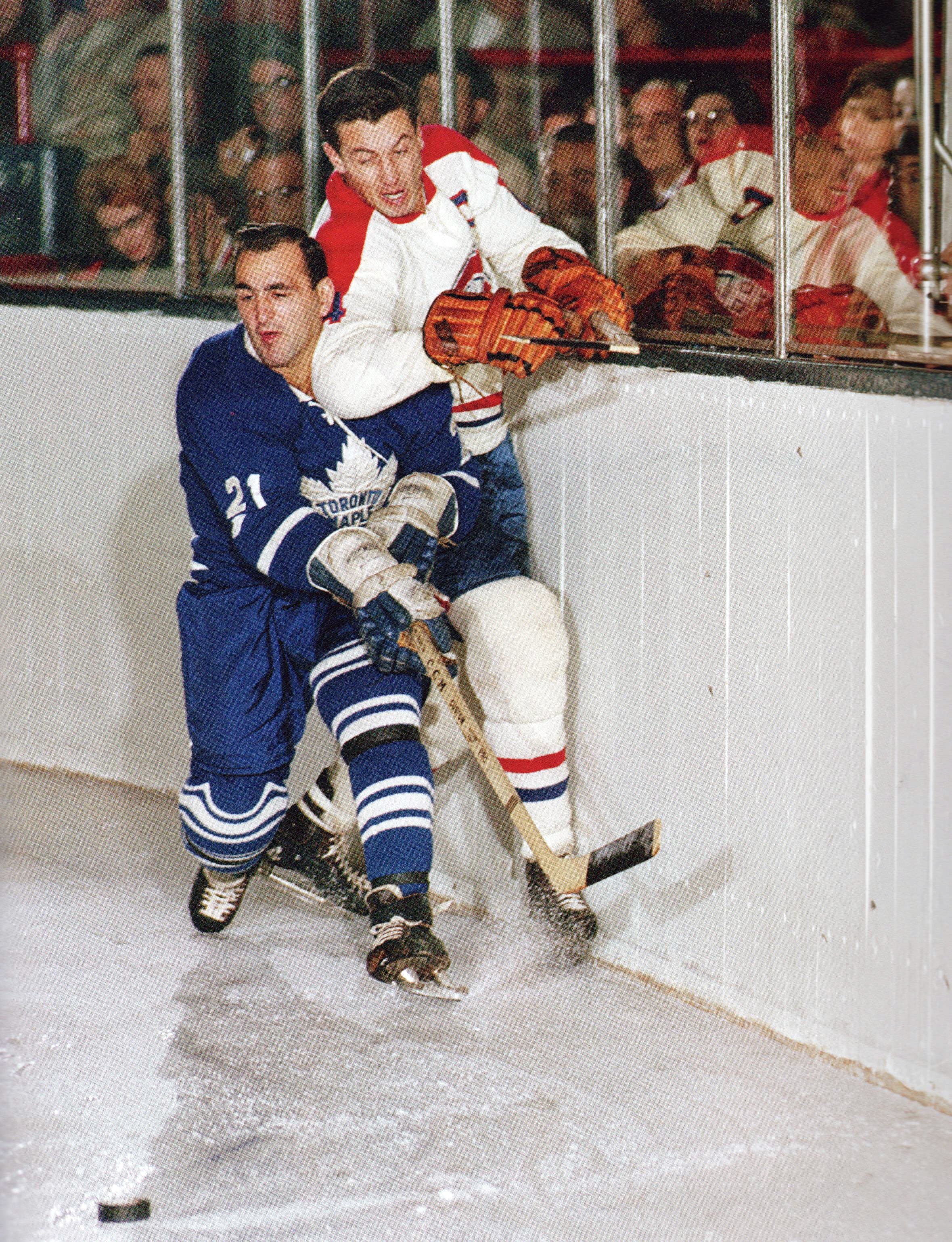
Fighting is one thing, toughness is another, and the best Leaf teams always understood the difference.
Now, people will then reply that Imlach’s Leafs had “tough guys” like Bobby Baun and Tim Horton and company. Damn straight, they were tough. But those fans saying this are usually just trying to make a case for a guy like Colton Orr.
I’m saying “toughness” and “fighting a lot” actually stand well apart. So here is precisely how often the eight defencemen from the Leafs famously-tough 1960’s Cup teams fought:
- Tim Horton – Just 17 fights in a 22 year career. The math here isn’t complicated. That’s less than one fight per season.
- Bobby Baun – Famous for his body-checking, but was also willing to fight. His record: 40 fights in a 17 year career. That’s between two and three fights per season.
- Allan Stanley – 16 fights in 21 years.
- Larry Hillman – 16 fights in 13 years.
- Marcel Pronovost – one fight in 19 years.
- Carl Brewer – nine fights in 10 years.
- Al Arbour – eight fights in 11 years.
- Kent Douglas = 15 fights in 7 years.
The main eight Leaf defencemen of the 1960’s averaged one fight each per season.
To compare, Colton Orr and Tie Domi had individual seasons where they fought 25 to 30 or more times, which is why I say hockey went a bit insane after the Big Bad Bruins and Broad Street Bullies came in. But we shouldn’t mix up that idiocy — the game the goons created — with the game that actually made the Leafs great.
Want to talk great? Look at the Leafs Shanahan put on Legends Row.
- #9, Captain Syl Apps. Won three Cups, averaged just six penalty minutes per year.
- #10, Captain Ted Kennedy. Five Cups, averaged just 33 minutes a year.
- #10, Captain George Armstrong. Four Cups, averaged 36 minutes a year.
- #13, Captain Mats Sundin. Only two major penalties in 13 seasons with the Leafs.
- #27, Captain Darryl Sittler. Averaged 59 minutes a year.
- #21, Borje Salming. Just five fights in 17 years.
Now, were they tough? Absolutely. Syl Apps served in WW2, Borje Salming led the way for Europeans into the league, and George Armstrong was half-Ojibway.
So, the Leafs were always tough, but fighting was far less essential to the Leafs success than certain media voices would have us believe.
Now, to close, here’s a multi-million dollar question for you.
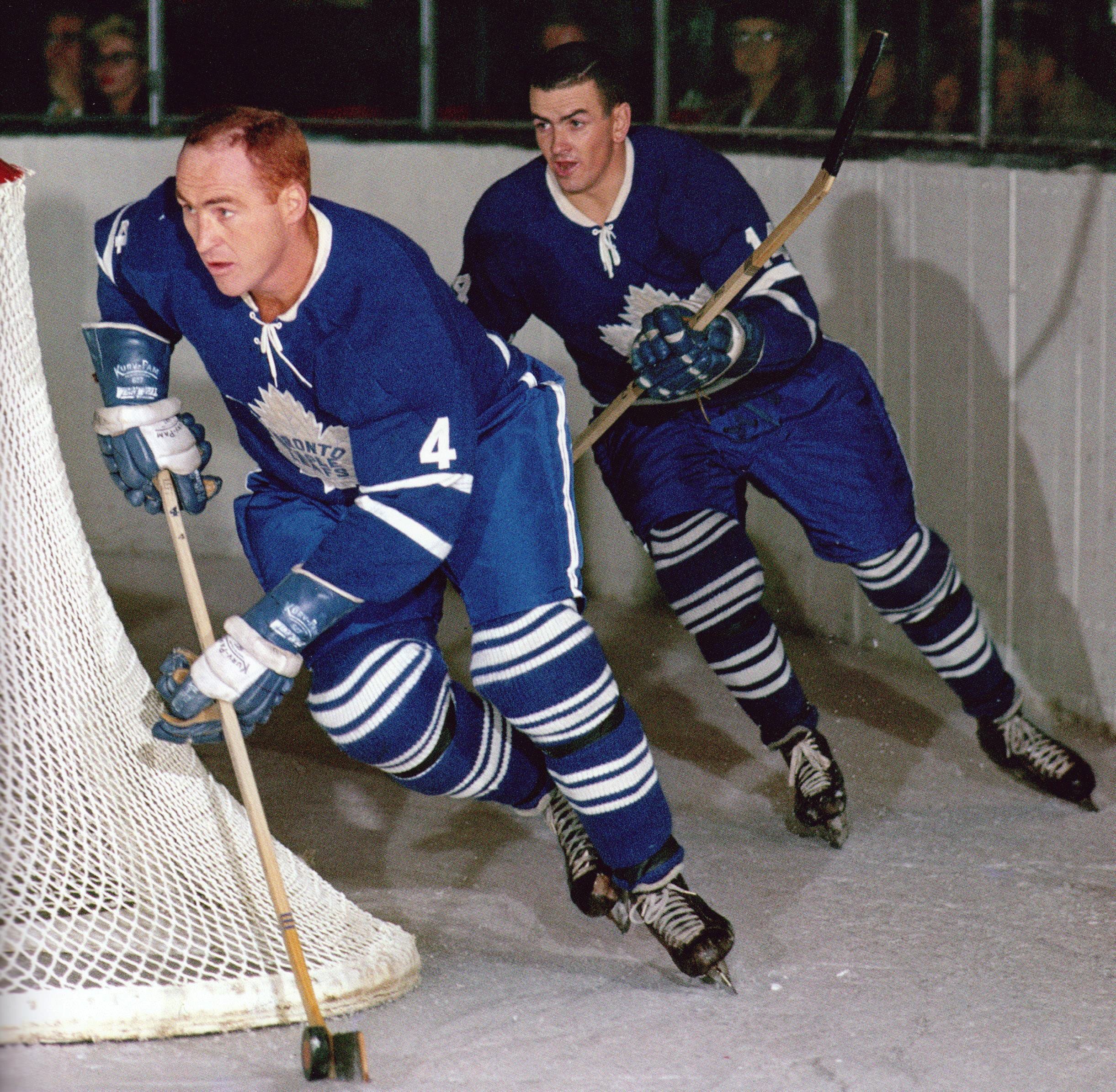
The loudest pro-fighter voices around have never been guys like Dave Keon or Syl Apps or Red Kelly. Instead, the single biggest bullhorns talking up how the Leafs need to fight more have been players like Don Cherry and John Brophy — career minor leaguers, guys who couldn’t break into the NHL even at its slowest.
Now, why would they possibly advocate fighting?
Well, it might have something to do with the fact that when a Cherry or a Brophy had to keep their gloves on — and skate and pass and shoot and you know, actually play hockey — they weren’t good enough for the NHL.
But when a Cherry or a Brophy dropped the gloves — and the game shifted from hockey to fighting — they were better than a lot of NHL’ers.
So, they talked up the part of the game where they had an advantage, which is something politicians and salespeople and the like do every damned day. It’s why we hear the same pitch from the fourth liners and ex-brawlers on hockey media, even today. But the reality remains: The Toronto Maple Leafs won their Cups without a lot of fighting, and if you believe anything different, then you’ve been sold some soap, my friend.
Rather, it’s Brendan Shanahan and Mike Babcock’s New Generation Leafs — more disciplined, tighter defensively, aiming to possess the puck, and refusing stupid fights — who are playing in the style of the great Toronto Maple Leaf teams.
So the next time some fan starts in whining about how we need to trade some talent away to add more guys like Colton…
Go print them out a Philadelphia Flyers schedule.
Hand it to them politely, and smile.
And tell them Toronto’s maybe not the team for you.
Read the rest of the series here:
- Brendan Shanahan gets “puck possessed” – Part I
- Reversing the curse – Part II
- Shanny listens to his Leaf gut – Part III
- Nylander, Kapanen and Shanny’s Fancy Foreign Friends – Part IV
- Shanahan and Soshnikov – The Kid Who’s Scared of Nothing – Part V
- Nikita Zaitsev: Part of the new Maple Leaf Russian 5? Part VI
- Brendan Shanahan: He’s Changed – Part VII



